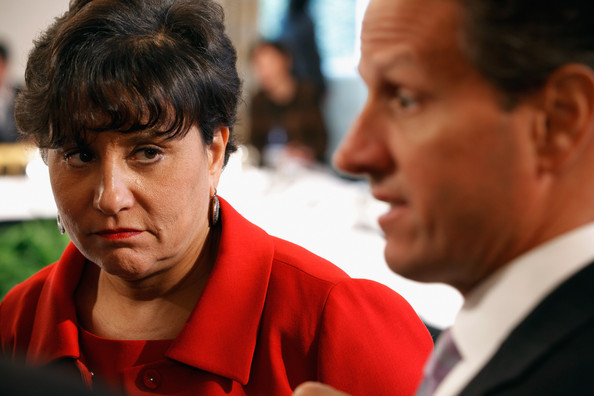By her own admission in a 2008 Q & A with the New York Times, Secretary of Commerce nominee Penny Pritzker acknowledged as many as 1600 depositors lost $6000 on average–or roughly $10 million overall–due to her family’s Superior Bank failure. The losses were the result of years of subprime lending and overvaluing its residual interests after failing to discount to present values, future cash flows that were subject to credit losses.
According to the U.S. General Accounting Office:
Superior Bank did not properly value the residual interest assets it reported on its financial statements. Since those assets represented payments that were to be received in the future only after credit losses were reimbursed, they needed to be discounted at an appropriate risk adjusted rate, in order to recognize that a promise to pay in the future was worth less than a current payment…
The result was that Superior Bank reported assets, earnings, and capital that were far in excess of their true values…When Superior finally applied the appropriate valuation techniques and related accounting to the residual interests in early 2001, at the urging of the OTS (Office of Thrift Supervision), Superior was forced to take a write off against its capital and became “significantly undercapitalized.”
The Pritzkers purchased Superior Bank (formerly the failed Lyons Savings Bank), with a New York real estate developer, Alvin Dwarman in 1988 from the federal government for a modest $42.5 million and $645 million in tax credits. Penny Pritzker then became Superior Bank’s first chairman before becoming director of its holding company Coast to Coast Financial holdings.
Under Pritzker, the bank’s composite rating had initially improved, and Superior began paying dividends of approximately $200.8 million to its holding companies. Because of Superiors’ improved status, by 1993 it required less oversight from regulators.
In March of that year, Superior “executed its first securitization of subprime mortgage loans and began booking residual interests on its balance,” the GAO report said. An OTS examination in 1994 reported that Superior’s continued investment in the residual interests originated by Superior exposed them to a higher risk, and by 1995 Superior began an even risker subprime auto lending division.
The GAO report says, “An FDIC official stated that Superior used its improper valuation technique from 1995 through 2000.” The bank’s ratio of nonperforming assets to total assets by December 1998 was 233 percent higher than similar institutions.
In 1999 the FDIC attempted to participate in the OTC’s regulatory examination. However, its request was denied by the by director of the OTC. By May of that year, Superior’s composite rating declined due to its substantially risky practices, according to the GAO report.
In October 2000, both the OTC and FDIC paid a visit to Superior and concluded their financial statements were not fairly stated in the most recent audit, conducted by accounting giant Ernst & Young. In 2001 Superior and Ernst & Young revaluated the financial receivables and overcollateralization assets using the correct method, which resulted in their required write-down of $270 million. The OTC approved Superior’s amended capital plan and issued a Prompt Corrective Action Directive that would require the bank to increase its capital levels–which Pritzker interests ultimately rejected, resulting in the FDIC takeover of the bank.
In order to avoid any enforcement action or levies, the Pritzkers agreed to pay $460 million over 15 years, but because the repayment was interest-free, the settlement was equivalent to $335 million.
The New York Times reported on Sunday that depositors at the bank are still out $10 million after losing a lawsuit against the Pritzkers to get their money back.
The Times noted:
Ms. Pritzker in 2008 defended her family’s refusal to pay uninsured depositors more than the deal reached with regulators, noting the legal principle “that there should be only one representative for a failed institution, the F.D.I.C.,” and stressing their contributions to the receivership.
Mr. Krislov (the depositors attorney) said the Pritzkers won an unusual deal allowing bank shareholders to be paid from recovered assets before depositors, which, along with the tax credits they obtained in 1988, meant “they came out ahead.” He portrayed the episode as showing “that the very wealthy get special deals the rest of us don’t get.”
And while Pritzker has attempted to distance herself from the failed bank in the past, an FDIC report said, “The failure of Superior Bank was directly attributable to the board of directors and executive management ignoring sound risk diversification principles as evidenced by excessive concentrations in residual assets related to subprime lending.”
According to a 2003 Forbes article, the federal government estimated the bank’s failure cost taxpayers $428 million or more on top of the assistance already given to the Pritzkers and Dwarman when they purchased the bank in 1988. In 2001 The New York Times estimated the total cost of the failure to the government could total as much as $1 billion.
To top it off, now that Pritzker has been nominated to the Commerce department, while the Times along with other papers around the country find themselves having to cover Pritzker’s failed bank deal, they are incorrectly reporting the Pritzkers paid back $460 million.
In fact, the Washington Times reported last year, after paying $316 million, the family made a deal with the FDIC to forgive the remaining $144 million balance.
Despite President Obama’s anti-fat cat, anti-corporatist rhetoric, his nominee for Secretary of Commerce, Penny Pritzker appears to fit that exact mold which he publicly pretends to detest.
Penny Pritzker and her family bank made subprime lending cool, before the subprime-lending crisis. As the beneficiary of sweetheart deals like this, Pritzker represents cronyism in its highest form.

COMMENTS
Please let us know if you're having issues with commenting.